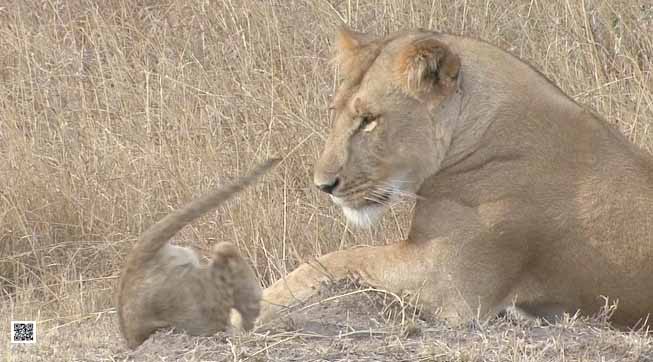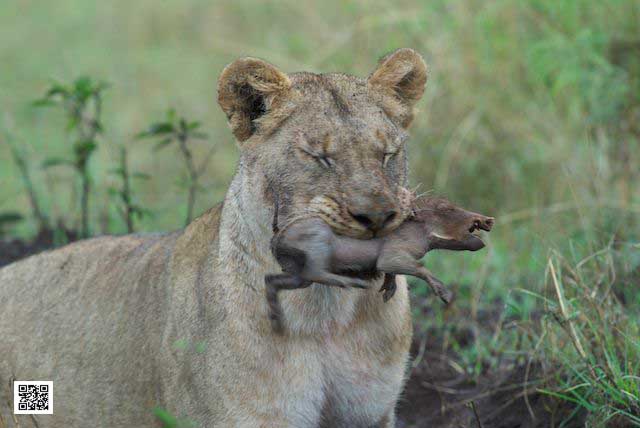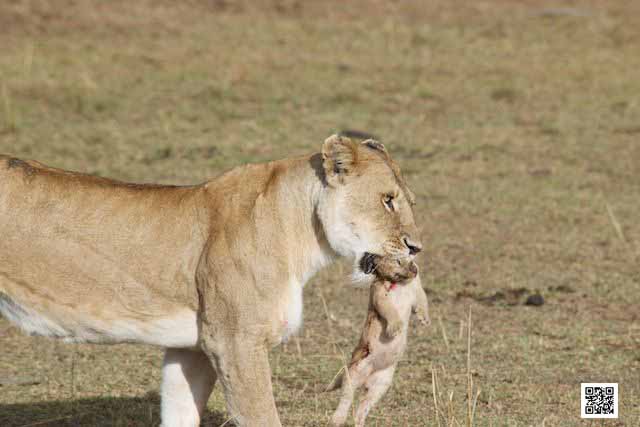lioness
On Photo Safari: Watching a Lion Cub Learn
29/09/12 18:24 Filed in: Safari Story

How do lion cubs learn? Just as children by playing, falling and standing up and teasing the adults.
We were on photo safari in the Masai Mara when we spotted a lion pride with a little cub, as it turned out later the little star of the family. There were more sub adult young lion, but only one little cub, the baby of the family. Just as young children, little lion cubs love to play and by doing that they learn important skills for their life in the bush. In this case the little lion cub felt very confident with his mother and aunts around to explore the mount they were lying on. Unfortunately the mount had a whole on one side, what made a good rim to sit on, but for a “feeling confident” little cub it became a trap, not a dangerous one, but he made a good role head first into it. His mother watched him calmly and maybe even amused when he lost his balance and fell over into the whole. But no worries, he was just learning about his balance. He climbed out and found a new target, his older brothers. The first brother’s tail became the subject of learning how to bite in moving objects. His brother made in a gentle way clear that this was not what his tale was there for and the little cub moved on to the second brother. He did that by stalking him carefully, just like he would do during a hunt and then jumped on him, biting in his neck. His brother didn’t even move, the little one was to little to heart him and only practicing hunting. However, the little cub seemed very pleased with his results and took a nice nap using his brother’s belly as a pillow, before he embarked on new adventures of his young life.
Ute Sonnenberg for www.rohoyachui.com
On Photo Safari in the Serengeti: Lions on Warthogs
22/09/12 20:09 Filed in: Photo Safari | Photography & Art

We were on a morning game drive on the Klein’s Concession in the Serengeti. It had rained and the moisture was still hanging in the air when we drove through the forest just behind our camp. Our Masai tracker Steve spotted lion, feeding on a kill. As we came closer we saw that it were all young lion, sub adults, probably on an expedition not far from the main group of the pride. They were feeding on a warthog and we could see that they had dug out the warthog from his burrow, lots of earth had been moved and there was a big whole.
After a while watching them, one lioness went into the warthog’s burrow and came out with a young warthog, still alive and screaming. She was looking like she didn’t really know what she was doing, following more an instinct then being hungry or wanting to hunt. The young warthog would die without its mother, either starving to death or being killed anytime later by other predators or scavengers. It was better to make it short and that might have been the silent assignment of nature for this lioness. She killed the young warthog and ate it and she went back to the burrow and came back with another one and another one. There had been three young warthog without mother and the young lioness did what she had to do, although she didn’t do it fast. Our Masai tracker Steve couldn’t watch it, because the youngsters were still alive for a few moments. He wanted her to do it fast and easy for the little ones, but maybe the lioness was just too inexperienced to understand that.
It was an impressive sighting, showing the innocence in the face of a young lioness while holding a struggling young warthog in her mouth, causing it pain and stress, before eventually doing what she is supposed to do. Nature is pulling the strings.
Tweet.
Ute Sonnenberg for www.rohoyachui.com
Photo Safari in the Serengeti: A Day with Lions
15/09/12 11:19 Filed in: Photo Safari | Travel & Inspiration

It was in the Serengeti when a pride of lion was lying in the grass, cubs playing and the females keeping an eye on the plains. This is just that incredible thing in the Serengeti that you can overlook the entire area and not only the lion can, also the photographer when looking out for photographic opportunities on a photo safari.
We spotted the lion on a morning game drive and while watching and photographing them a herd of zebra approached. That was promising. Maybe we could witness a hunt! We retreated a bit from the scene to not disturb the animals and waited. The zebra herd was lead by a stallion. He walked in front of them scanning the area, head up and alert. The lion pride had disappeared from earth as soon as they saw the zebras approaching. They were all down in the grass, no movement nothing at all to see of them. Nonetheless the leading zebra stopped about 60 meters away from the pride. The rest of the zebra herd just carried on grazing, but stayed behind the stallion, some of them even playing. The stallion and the herd stood there for at least 10 minutes and just at the moment that the stallion was about to carry on the big male lion of the pride popped up his head. He had been sleeping away from the females and cubs in the grass and had just woken up, wondering where his females are. When the stallion saw he male lion he stopped again, looked at him and them turned around and walked away where he came from. The herd followed him. There was no fast movement of any zebra, no panic, nothing and there was not attack of the lion. The females popped up their heads when the zebras had turned and walked away. Only one sub adult female an after the zebra, but only for a short distance. Nobody joint her. The lionesses are too wise to waste any energy. They knew they wouldn’t have a chance to catch a zebra, so they just carried on with what they were doing before the zebras arrived.
This was an incredible sighting and we decided to stay with them, but move away for now to have some breakfast at a nearby rock. While having breakfast we saw that a buffalo heard was approaching the lion pride and the buffalos had a completely different strategy than the zebras. They had seen the lion and they immediately started attacking them, because they wanted access to a nearby water whole (probably the zebras also wanted to get to the water whole, but they do not have the strength of buffalos). The buffalo’s lion chase made that the pride was scattered over the whole area, which makes the weak. After a few moments also the lion seemed to realize that and organized themselves again. The buffalos were at the water whole drinking. The lion let their cubs under a distant group of trees and each lioness and young male lion took position on a termite mount. They set up an ambush for the buffalos for when they would leave the water whole. Ambush in this case meant that the lion had positioned themselves to take advantage of a hunting chance, but they were completely visible on the termite mounts. They were waiting. After quite a while the buffalos started moving off, but unfortunately for the lion in the wrong direction away from their positions. The lion left their termite mounts and met with the cubs under the trees. All were lying down in the grass again, again not wasting any energy.
Later on in the afternoon, still at the same spot and still lying in the shade and the cubs playing, a heard of elephants approached. And also the elephants made clear that they don’t want the lion around and chased them away. The lion moved off and lied down in the grass away from the elephants. They knew there was no hunting opportunity and again they saved their energy for better opportunities probably occurring during the night.
Being able to follow the lions throughout the day, well actually being with them the whole day in the same spot, was a great photographic opportunity and also a great learning experience from the photographic point of view and animal behavior point of view. They are so much wiser than we are … well probably except that male lion.
Ute Sonnenberg for www.rohoyachui.com
The Mourning of a Lioness in the Masai Mara
20/07/12 17:52 Filed in: Photography & Art | Travel & Inspiration

It was on a morning game drive in the Masai Mara when we spotted a lioness lying on the grass and holding something between her paws. It looked like a small animal and we thought it might be a hare or other small animal she was feeding on. But she was not feeding. She was holding it and looking around as in despair. As we came closer we saw that she was holding a little cup between her paws and the cub was not moving, it was obviously dead, only a few weeks old. The lioness started licking the cub, moving it with her paws, trying to revive the little body, but it wouldn’t come to life. Between her attempts to revive her cub she was looking up, opening her mouth as if she wanted to scream, but no sound was to be heard, it were silent screams of sadness and pain of the mother of a lion cub.
After a while she stood up, grabbed her cub with her mouth and carried it into higher grass. There she put her cub down and stood there looking at it until she moved away to a nearby tree. The lioness lay down under the tree, closed her eyes and rested. She stayed there for hours. In the late afternoon she got up and walked back to her dead cub. Then started eating her cub, maybe in some attempt to make sure that it goes back to where it was safe. After this final act of mourning the lioness left the site and walked back to the rest of the pride that had been waiting for her on a close by clearing. They had respected her need to mourn and she had taken the time she needed.
Nature will bring her straight away into estrus and she will have new cubs with hopefully a happier ending.
Ute Sonnenberg for www.rohyachui.com